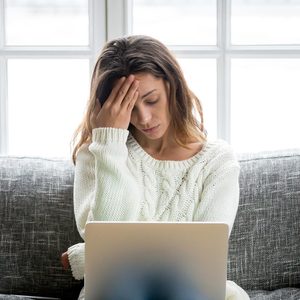When anxiety about health is a condition itself
With the threat of a second coronavirus wave and the start of cold and flu season, it’s easy to worry that each sore throat, cough or headache may turn out to be something far worse. You consult Dr. Google as you frantically type in all of the symptoms you have—or think you have.
It’s important to note that worrying about COVID-19 is “being appropriately nervous about your health,” according to Steven L. Dubovsky, MD, professor and chair in psychiatry at the University at Buffalo in Buffalo, New York.
However, there are some instances where preoccupation about your health evolves into an obsession and an unrealistic fear. Healthy anxiety, once known as hypochondria or hypochondriasis (a person with hypochondriasis would be a hypochondriac), is now known as illness anxiety disorder. (Here’s what to do if you’re waking up with anxiety at night.)
“Hypochondriasis refers to a preoccupation with having an illness that you either don’t have or a preoccupation that whatever illness you do have is much worse than it actually is,” says Dr. Dubovsky.
Our panel of experts explains everything you need to know about illness anxiety disorder, including the causes, symptoms, and treatments, as well as how to tell if your health concern is rational or irrational.
What is illness anxiety disorder?
You might joke that someone is a hypochondriac if they have a rash or ache and are convinced it’s something incredibly serious, but like any mental health condition, health-related anxiety is anything but funny.
Hypochondria was updated in the Diagnostic and Statistical Manual of Mental Disorders 5th Edition (DSM-5) to illness anxiety disorder. The definition: A “preoccupation with having or acquiring a serious illness.”
For instance, you may constantly check your body for signs of illness. Your mind may also jump immediately from “A to Z,” says Susan Albers-Bowling, a psychologist at the Cleveland Clinic in Wooster, Ohio.
For example, you may think your cough is actually lung cancer and then you develop obsessive thoughts about it that interfere with your day-to-daily activities. So, how do you tell the difference between illness anxiety disorder and a legitimate health concern? A legitimate health concern can be something that you can easily see or measure. (Here are eight signs that you could have Obsessive-Compulsive Disorder.)
For example, if you have a high fever of 103 F (39.4 C) or more, this is a legitimate concern that warrants a visit to your doctor immediately.
Somatic symptom disorder is a related disorder. Here, you actually experience physical symptoms like pain or shortness of breath, that may or may not be related to a health condition.
The feelings related to those conditions are so excessive and distressing that they can occupy your thoughts and behaviours, and even compromise your ability to live your life, explains the American Psychiatric Association. This disorder usually begins by age 30.
What causes illness anxiety disorder?
Illness anxiety disorder can be a way of solving past problems by having a preoccupation with your bodily functions, says Dr. Dubovsky.
“True hypochondriasis usually occurs in people who were deprived throughout childhood and have a constant feeling as an adult in not being cared for. It’s a way of legitimizing these dependency needs that someone doesn’t feel comfortable meeting in other ways,” he says.
The U.S. National Library of Medicine notes that this may also stem from a history of physical or sexual abuse. This isn’t the case for everyone, however, and you don’t necessarily have to have this type of history to develop illness anxiety disorder.
Symptoms and diagnosis of illness anxiety disorder
Some anxiety over your health is a good thing because it motivates you to see a doctor and stick with treatment, says Bowling.
According to the U.S. National Library of Medicine, you may have illness anxiety disorder if:
- You believe that any symptom or sensation is a sign of a serious illness
- You regularly see doctors for reassurance that you are not ill. (You may also ask friends and family)
- Your symptoms are vague and may change
- You regularly examine your own body for signs and symptoms something is wrong
According to the American Psychiatry Association, you may have somatic symptom disorder if:
- You have one or more physical symptoms that are causing you distress in everyday life
- You have obsessive and out-of-proportion thoughts about the symptom
- You have high anxiety about your health
- You spend excessive time on your symptoms
Know that the very stress of worrying about your symptoms can trigger anxiety symptoms that feel like something is wrong, like irritable bowel, nausea, fatigue, aches and pains.
“People are often experiencing real, genuine symptoms, some of which are created by the stress of worrying about it,” says Bowling.
To diagnosis illness anxiety disorder, your doctor will do a physical exam to see if you have any of the health conditions you’re worried about.
If you don’t, your doctor will likely refer you to a mental health professional for a psychological evaluation. (These are the signs you could use the help of a therapist.)
Treatment for illness anxiety disorder
Treatment for illness anxiety disorder usually addresses your symptoms and how to deal with them on a day-to-day basis so they don’t interfere with your life.
Psychotherapy and medication are typically recommended to ease the unsubstantiated fear and worry triggered by this anxiety. Here’s what you need to know about treatment options.
Psychotherapy
Cognitive behavioural therapy (CBT) focuses on reframing your thoughts to dial down anxiety. “Your mind is catastrophizing the situation,” says Bowling. Catastrophizing is when your mind races to the very worst possible outcome of a situation; you may be convinced that you are in grave, life-threatening danger, even if it’s the least likely explanation for your symptoms.
A therapist, she says, can teach you strategies to be less reactive to fearful thoughts and better cope with anxiety. For example, you might use deep breathing techniques rather than calling your doctor right away. If the symptom is still there for three days, then you might call. (Read these tips on how to get the most out of therapy.)
Acceptance exercises can also help. The goal of worry is often to prevent something bad from happening, but it’s important to realize that not everything is within your control, says Bowling.
Controlled worrying (done within the constraints of a specific time period) will allow you to worry but prevent the all-day anxiety cycle that can consume your mind.
Medication
Medication to treat anxiety, including serotonin specific reuptake inhibitors (SSRIs) or serotonin-norepinephrine reuptake inhibitors (SNRIs) can help, specifically those used for obsessive-compulsive disorder like fluoxetine (Prozac) or venlafaxine (Effexor).
SSRIs work to promote serotonin, known as the “feel-good” brain chemical, while SNRIs function to increase the release of both serotonin and norepinephrine, which promotes alertness and energy. It’s important to talk with your doctor about potential side effects from these drugs.
Lifestyle changes
One of the most important things you can do is to quit Googling your symptoms, although that can be difficult.
“Leave the diagnosis to the doctors,” says Bowling. Talk to your doctor if you need help limiting your electronic use.
Patients should also have one primary care physician in order to minimize tests and treatments, says the U.S. National Library of Medicine.
Stress reduction strategies, including exercise, meditation, maintaining a healthy diet and getting enough sleep can also help lessen anxiety. (Here are 10 possible medical reasons why you can’t sleep.)
Complications and prognosis from illness anxiety disorder
If not treated, illness anxiety disorder or somatic symptom disorder can spiral into obsessive doctor’s appointments, bouncing around from doctor to doctor trying to find the cause of your symptoms, or seeking out multiple tests or scans.
“This can be time-consuming and expensive and may exhaust your health insurance,” says Bowling.
Even more severe: If you get enough tests, eventually one of them may show an abnormality, and you can be harmed by unnecessary follow-up tests or even unneeded exploratory surgery, all of which can cause complications, adds Dr. Dubrovsky.
However, with treatment, which may include CBT and/or medication and some lifestyle changes, you can learn to let go of the excessive worry and anxiety in hypochondriasis and learn to cope in a productive way, says Bowling.
Next, learn about autumn anxiety and how to cope.
How to sleep with anxiety
No one gets a good night’s sleep every night. But sometimes a restless time in bed can be caused by worry and stress that builds up over time, leading to anxiety at night.
Night time anxiety can cause you to wake up at an unusually early hour (say, 3 a.m.), feel like you haven’t had enough sleep, and then feel pressure to go back to sleep, explains Virginia Runko, PhD, a behavioral sleep medicine specialist and psychologist in Washington, D.C.
You may toss and turn as your mind dwells on your worries from the day before, then races off thinking about a crisis you can’t control. If you struggle with insomnia and have anxiety, you may have a pattern of waking up unusually early and having trouble getting back to sleep. (Here are the seven types of insomnia that can keep you up at night.)
Called sleep-maintenance insomnia, it affects more women than men. You typically start to worry about getting back to sleep at a reasonable time, and you also may have thoughts that become more dire and even irrational.
Anxiety can happen at any time of the day, including the morning, afternoon and at night. Typical symptoms of anxiety can include nervousness, worrying, the inability to focus, as well as trouble falling or staying asleep. (The season might be making you more stressed. Autumn anxiety is real—here’s how to cope.)
Sometimes, if you experience anxiety during the night, you may even have a nocturnal panic attack. These panic attacks have the same symptoms as a daytime attack, ranging from heart palpitations to experiencing feelings of extreme fear. (Learn the difference between an anxiety attack vs. panic attack.)
Here’s everything you need to know about this type of anxiety, why it happens at night, and how to cope with it.
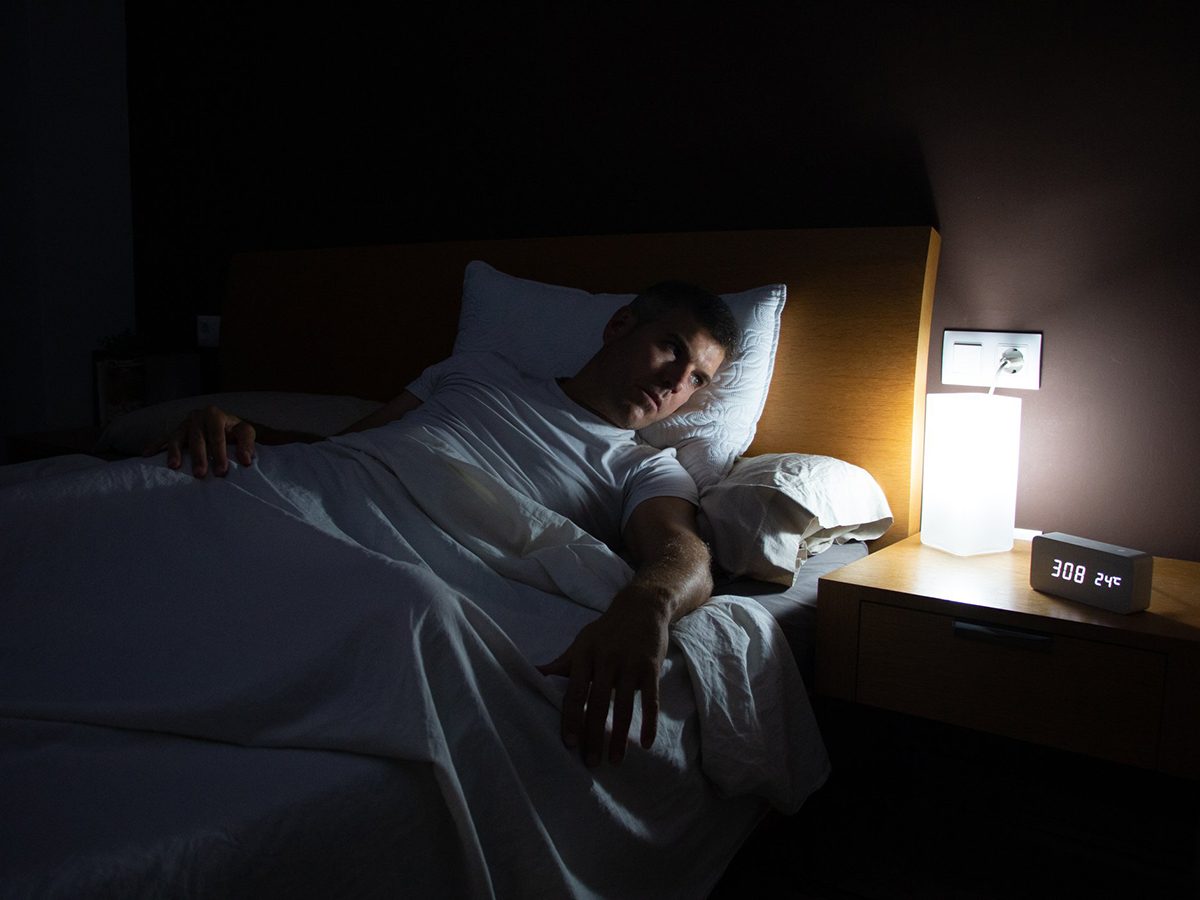
Causes of anxiety at night
When you wake up in the middle of the night with anxiety, the cause may be an internal or external stressor. Here are a few common ones:
Stress
Your stress levels may be at a high right now because of the COVID-19 pandemic, social unrest and the upcoming election. You also may experience higher levels of stress at home if you are dealing with unemployment, financial instability or juggling childcare while working from home.
Worries are almost primed to reach a fever pitch overnight. “Some research shows that activity in your brain’s frontal lobe—the area responsible for rational thinking, executive functioning, and thought and behaviour inhibition—dials down overnight,” explains Runko.
If you have anxiety and are dealing with loads of stress, this stress can manifest itself during the nighttime as your mind is racing. The body begins to “prime” itself in a fight-or-flight response, which often causes what is known as an adrenaline rush. If you experience this at night, it makes it even more difficult to fall back asleep. (Try these 30+ stress management tips from the experts.)
Drinking alcohol
Drinking may have gone up in COVID-19 times, and alcohol isn’t good for your sleep, says Alex Dimitriu, MD, a dual board-certified doctor in psychiatry and sleep medicine in Menlo Park, California.
Alcohol may send you to dreamland quickly, but it also disrupts sleep in the second half of the night. You may wake up in the middle of the night, giving space and oppourtunity for your mind to start to wander and worry.
Checking your phone
In a 2018 study of young adults published in PLoS ONE, one in eight were using their phones in the middle of the night, specifically three to five hours after going to bed.
Being glued to your phone—especially if you’re checking potentially triggering content—contributes to anxiety, says Dr. Dimitriu.
Poor sleep habits
With COVID-19 throwing everyone’s normal schedule out the window, “you may be doing things that make it more likely you’ll wake up in the middle of the night, like going to bed really early out of boredom,” says Runko. (Follow these 11 weird tricks that really do help you go to sleep.)
Treatments
The key to treating your anxiety at night is to identify its root cause. Sometimes, there are medical conditions that can lead to anxiety symptoms, such as chronic pain, irritable bowel syndrome, hyperthyroidism, heart disease and diabetes. (Here are 10 possible medical reasons why you can’t sleep.)
If you have any of these preexisting conditions or suspect you do, it’s important to discuss with your doctor how to effectively treat them, which may help alleviate some anxiety.
Medication
Working with your doctor or a psychiatrist, you may be prescribed a variety of medications if the problem stems from anxiety. These may include selective serotonin reuptake inhibitors (SSRIs), which increase the presence of serotonin, the “feel-good” chemical, in the brain.
Serotonin works as a mood stabilizer and promotes feelings of happiness.
Another common anxiety medication option is serotonin-norepinephrine reuptake inhibitors (SNRIs), which works in a similar way to SSRIs. These drugs increase the levels of both serotonin and norepinephrine—associated with alertness and energy—in the brain. (This is what you need to know about generalized anxiety disorder.)
Psychotherapy
Cognitive behavioural therapy (CBT) helps you change thinking patterns that feed anxiety. It also teaches behavioural strategies that reduce anxiety and introduces coping options. Improvements with CBT can be seen in as soon as 12 to 16 weeks. (Learn about the 19 things you should do all day long for better sleep tonight.)
How to prevent night time anxiety
Meditation
Practicing mindful awareness can help improve your sleep quality, and reduce symptoms of insomnia and depression, finds a 2015 study in JAMA Internal Medicine.
Exercise
Physical activity reduces anxiety overall by increasing the level of neurochemicals in your brain that keep your mood up. Exercise also promotes sleep quality and how much sleep you get. (Here are eight steps to getting back into shape.)
Sleep schedule and hygiene
Improving sleep hygiene habits, which includes going to bed and waking up at a consistent time daily, can help improve your ability to stay asleep. It’s important to set up a bedroom that facilitates sleep (a dark, cool, quiet room, for instance). This will help limit stimuli that could wake you up at night and make it easier to fall asleep. (Learn why dream deprivation is just as unhealthy as sleep deprivation.)
Journaling
Try a worry control procedure, suggests Runko. At least two hours before bedtime, write out your worries or what’s making you particularly anxious in a journal.
“This allows you to process these thoughts earlier in the day, so you don’t feel like you have to go through it in the middle-of-the-night,” she says. And, write down the concrete steps you will take to deal with those worries.
For instance: You’re worried about your finances, so you’ll plan on coming up with a budget. If worries are more abstract, then a professional may be able to help guide you in CBT to help reframe your thoughts so they don’t weigh as heavily on you.
Still waking up? Runko advises telling yourself that you already thought about this problem, it’s in your worry journal, and you’ll revisit it tomorrow during the next scheduled worry time.
If it’s a “new” worry, go ahead and quickly scribble in your journal so that you can come back to it tomorrow.
What to do when you wake up anxious at night
Get out of bed. This is a strategy for dealing with insomnia and sleep-maintenance insomnia that experts like Runko teach their patients, and it comes from CBT for insomnia (CBT-1).
“If you’re anxious, you’re physiologically more awake, which can lead to conditioned arousal,” she says.
Move away from your bed and try a calm, sedentary activity that you consider to be a pleasant distraction. That can include TV (yes, really, but avoid triggering or scary programs), meditation, or reading a book.
Once you are again drowsy, go back to bed. (Here are 12 ways to wake up happier tomorrow morning.)
When to seek professional help
If nighttime wake ups are frequent, bothersome, or impact your quality of life, don’t hesitate to seek help from a therapist or a sleep medicine specialist. If you have anxiety, treatment may also include medication, like SSRIs or SNRIs, as previously discussed.
You should also focus on healthy lifestyle measures, like diet and nutrition, physical activity, mindfulness, and relaxation exercises. Your doctor, therapist, psychiatrist, or sleep medicine specialist can help you come up with a plan that will work for you.
Sources:
- Anxiety.org: “Do I Have Anxiety?”
- Anxiety and Depression Association of America: “Generalized Anxiety Disorder”
- Anxiety and Depression Association of America: “Sleep Disorders”
- National Institute on Alcohol Abuse and Alcoholism: “Director’s Blog: Alcohol poses different challenges during the COVID-19 pandemic”
- American Psychological Association: “What is Cognitive Behavioral Therapy?”
- Anxiety and Depression Association of America: “Medication”
- Anxiety.org: “Anxiety Treatments: Know Your Options”
Next, try these seven morning brain exercises to clear your mind.
How to build confidence and self-esteem
- A fear of failure can increase your self-doubt. Louisa Jewell, the president of the Canadian Positive Psychology Association, says the best way to ramp up your confidence levels is to do the thing at which you’re afraid of failing. That way, it becomes less daunting.
- Some people are wary of success—with achievement come unknowns. To counteract this, Jewell suggests focusing on the tangible and visualizing success and its upsides.
- Compassion is a necessary pillar of confidence and self-esteem, Jewell says. Make sure you cut yourself some slack in the event that you make mistakes, and remember that setbacks are part of being human.
- If you boost your confidence, you’ll accomplish more, says Stanford University professor Albert Bandura. Self-assured individuals, he explains, view difficult tasks “as challenges to be mastered, rather than as threats to be avoided.”
- To help achieve a confident mindset, Bandura recommends putting yourself in a good mood: stress and bad vibes result in what is called “negative self-efficacy.”
- Bruce Hunt, a Toronto public speaking expert who teaches confidence lessons, says a supportive social circle can provide the positive reinforcement integral to building self-esteem. In short, make—and keep—nice friends. (Here’s how to make new friends as a grown-up.)
- Consider finding role models who share your gender, age, race or professional background. Being able to see those mentors “do what we want to do makes us think maybe we can achieve it, too,” Jewell explains.
- In certain situations, knowing what others expect can boost confidence, says Hunt. So don’t be afraid to ask your boss or your colleagues what you should be aiming for to achieve your goal.
- Take it one step at a time and create deadlines to reach personal confidence milestones. If, for instance, you are trying to become a poised public speaker, gradually address larger groups for longer periods over time.
- If you needed another excuse to haul yourself to the gym, a 2013 article in the Journal of Physical Activity and Health described how being active can increase confidence and lead to more ease in relating to peers.
- It’s okay to be cocky. A collection of studies in the Journal of Personality and Social Psychology found subjects who were overly confident in their abilities to complete tasks were more respected and more likely to be perceived as competent.
- But be careful not to tip over into self-satisfaction. The upside of a mild lack of confidence is that we keep pushing ourselves to improve, “to push the envelope,” says Jewell.
Now that you’ve got these confidence lessons under your belt, check out these self-esteem boosting tips.
In May, three months after the novel coronavirus was declared a global pandemic, Stasia Norbett’s already shrinking world got even smaller. After suffering an eye stroke, the 86-year-old was told she wouldn’t regain vision in her left eye and had to give up driving, her main source of independent transportation.
Norbett lives alone and has been largely staying indoors to avoid the virus. Her kids drop off groceries and come by to visit her Mississauga, Ont. home, which makes her happy. But losing partial eyesight and her car has been hard—especially since it’s meant seeing her husband, who’s being cared for in a nursing home, a lot less often. Inside is lonely but outside is dangerous.
“I have a little cloud over me,” she says. “It’s difficult now because there’s no way of getting anywhere.”
The first wave of the COVID-19 pandemic disproportionately hit those in long-term care facilities to devastating effect, but it’s also had a significant impact on seniors living alone at home. Seniors are considered more at-risk for the serious health effects of COVID-19. Many are living with strict limitations on how they interact with others—restrictions that are either self-imposed, or come at the insistence of family terrified of passing on the virus. Many of their social activities, like community groups and seniors programs, have been suspended. The effects of loneliness and isolation are severe.
“Social distancing has had a very major impact [on seniors],” says Dr. Verena Menec, a professor of community health sciences at the University of Manitoba, who specializes in aging. “They are losing a big part of their social contact.”
Social isolation and loneliness is associated with numerous negative health outcomes in older adults, including cognitive decline, which can lead to dementia and depression, Menec says. Then there’s the physical health effects: heart disease, stroke and a weakened immune system. Loneliness is also linked to premature death and has been compared to smoking, physical inactivity or obesity in terms of its impact.
The pandemic has also made it hard to do the very things that combat its effects; visiting friends and family, volunteering, going to church and getting exercise are vital to helping prevent illness.
“A lot of their activities are a combination of stimulation and something that’s good for their health. If they have cognitive decline, for example, they may take an exercise class to improve it,” says Diana Brecher, a clinical psychologist at Ryerson University in Toronto. “So for seniors, it’s not just one thing: it’s a combination of things that they’ve lost.”
Caregivers are increasingly filling the wellness gaps caused by COVID-19. One quarter of people over 65 live alone, according to Statistics Canada, with 29 percent of Canadians over 90 living in a private household. Nearly one in four Canadians were caregivers as of 2018, StatsCan reports, with almost half of them caring for aging parents. (This finding is most common among those between the ages 45 and 64.) In Ontario, one of the hardest-hit provinces by COVID-19, there’s been a 22 percent increase in the number of family caregivers since the pandemic began, according to research by the Ontario Caregiver Organization.
“If you have kids at home, you’re caring for elderly parents, and you’re trying to work…you might have too many balls in the air. That can be incredibly stressful,” Brecher says.
Mary, a 60-year-old Brantford, Ont. resident (who is using her first name only for privacy reasons), is retired, but looking after her elderly parents has become a full-time job.
Her mom has Parkinson’s and dementia, and uses a wheelchair. Mary says her dad is also showing the early signs of cognitive decline. When Ontario first went into lockdown in March, Mary didn’t go inside her parents’ house for two months, and would only drop off food outside. She was also looking after her grandchildren — their mom is a front-line worker, and Mary didn’t want to risk bringing anything into her parents’ home.
“My father is the primary caregiver of my mother,” Mary says. “We’ve noticed that it’s starting to take a toll on his mental health.”
Now, with decreasing case counts in her daughter’s hospital and her parents’ increasing needs, Mary is at their home nearly everyday. She brings them food, cleans for them, makes sure they have supplies, like masks. She is grateful a personal support worker (PSW) now comes in four times a week; some senior care services were initially affected by the pandemic
Still, Mary worries about her mom and dad around-the-clock. She calls her father’s landline every hour that her mother needs to take her medication. She is scared what will happen if he forgets to give her pills. Mary says she and her brother plan to have their parents move into a nanny flat at his house in the near future so they aren’t on their own.
The pandemic is confusing to her parents. “My dad has a mask, but he doesn’t understand how to take it off, how to put a clean one on and how to wash it,” she says. “I don’t think my parents could manage without having a PSW and without me checking in every day.”
Brecher looks at the recent nation-wide call to get kids back to school, which is seen as both critical to kids’ mental health and the relief of working parents, and wonders why there hasn’t been a similar call for a safe, gradual return to activities for seniors.
“The age spectrum is vulnerable to the effects of social isolation in different ways because it manifests differently,” she explains. “But I think the issue is the same: people need social stimulation.”
Next, here’s how to care for aging parents during COVID-19.
The designers at IKEA are renowned for problem-solving. Between flat-packed furniture and space-saving storage units, the entire brand is built on finding common sense solutions to modern-day dilemmas. Their latest innovation, however, is poised to eliminate one of the most pernicious household hazards known to parents and grandparents the world over: Stray LEGO bricks.
The new Bygglek storage boxes, created in collaboration with designers at LEGO, are specifically designed to corral those colourful interlinking blocks that tend to lay scattered across playroom floors in wait for an adult’s unsuspecting foot. In keeping with IKEA’s innovative approach, the storage collection serves double-duty as LEGO itself, with box lids becoming LEGO baseplates—a ready-made foundation for your little ones’ latest creations.
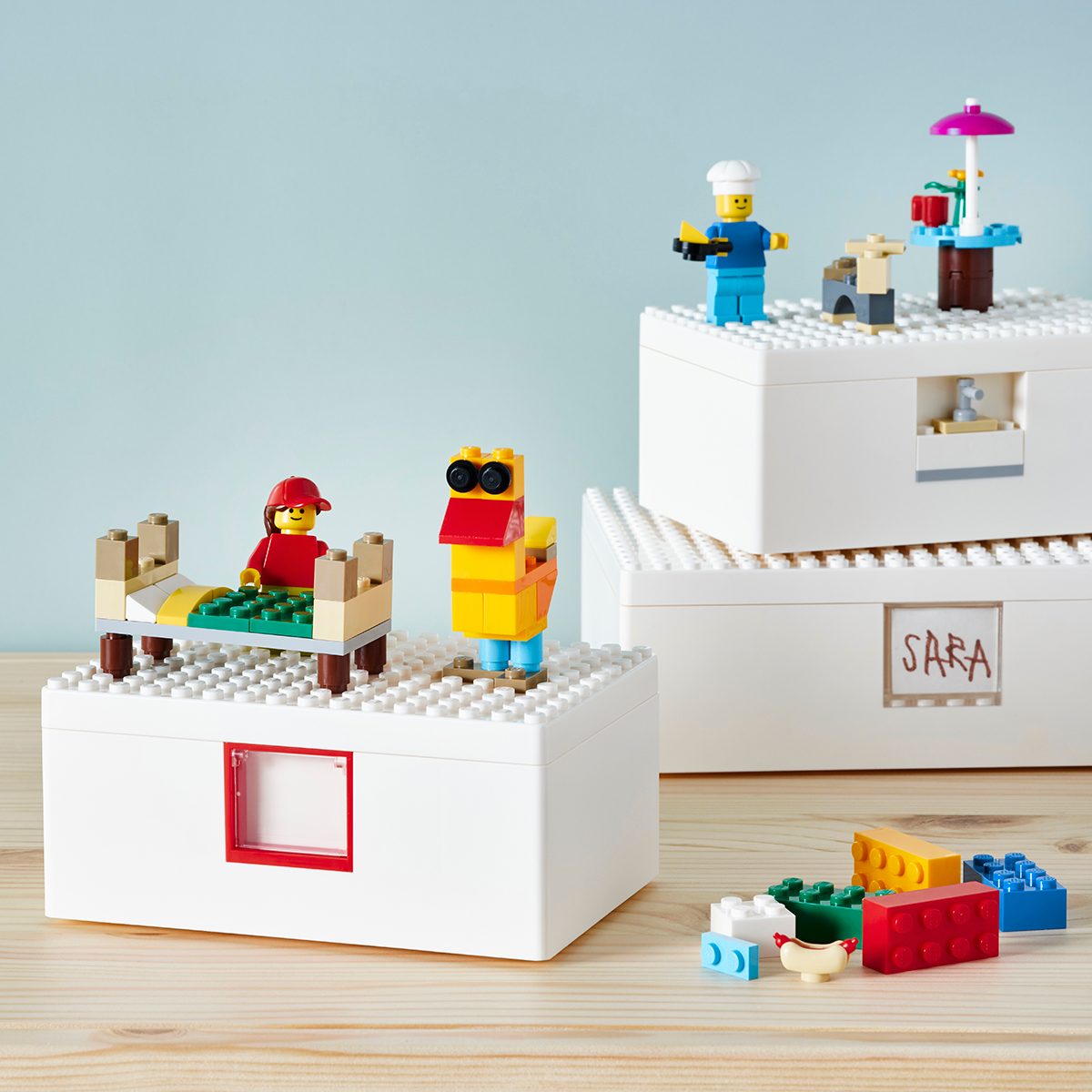
Available online and at IKEA stores across Canada beginning October 1, 2020, the Bygglek collection will consist of four different storage box sizes, as well as a 200-piece LEGO brick set (including two LEGO character figures, of course!), exclusive to IKEA.
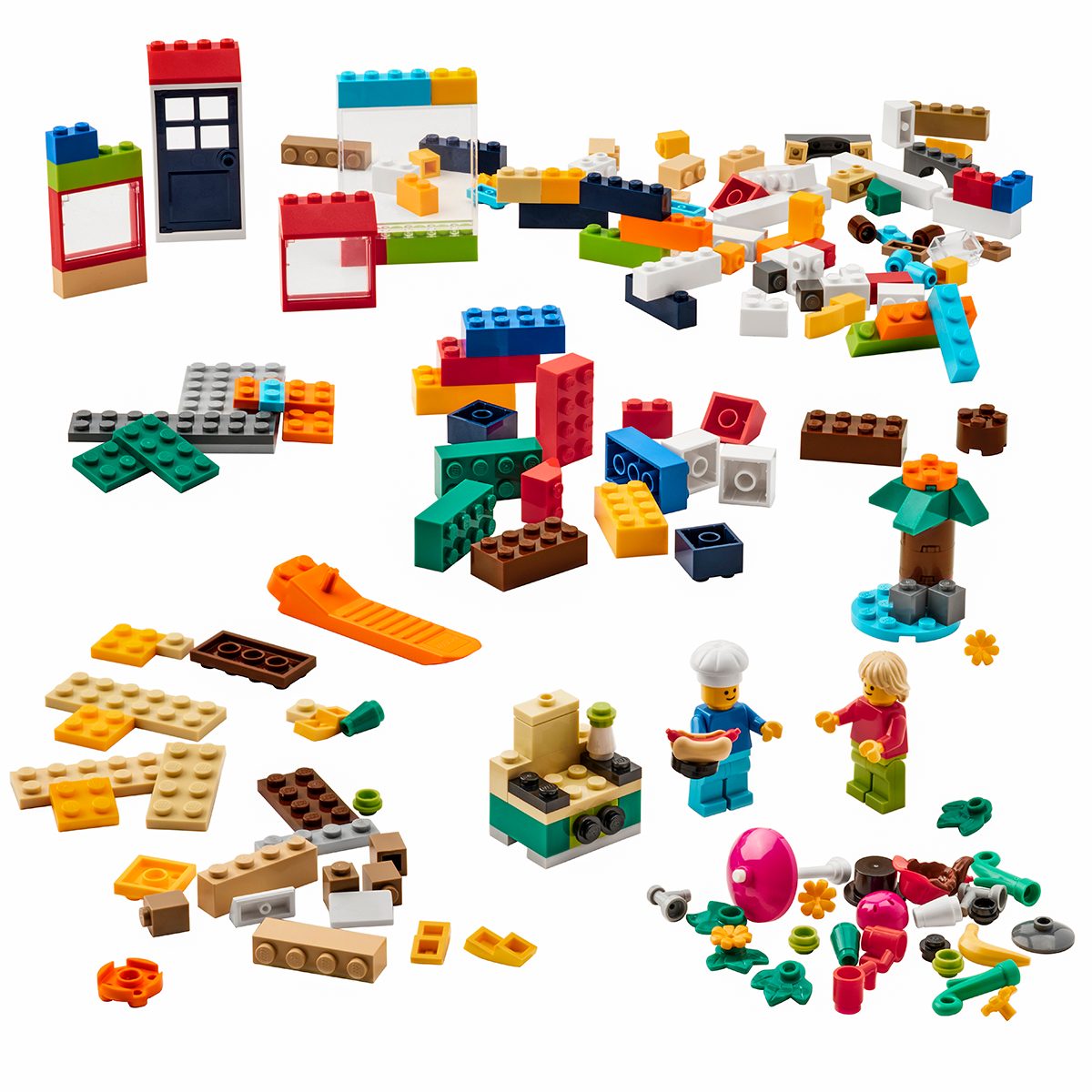
The boxes in the Bygglek series are fashioned from the same durable plastic as LEGO products, making for a seamless integration. “I still have my LEGO bricks from the ’70s. You never throw them away,” explains IKEA designer Andreas Fredriksson. “You keep them or pass them on to the next generation. It is important that Bygglek has the same quality and the same feel.”
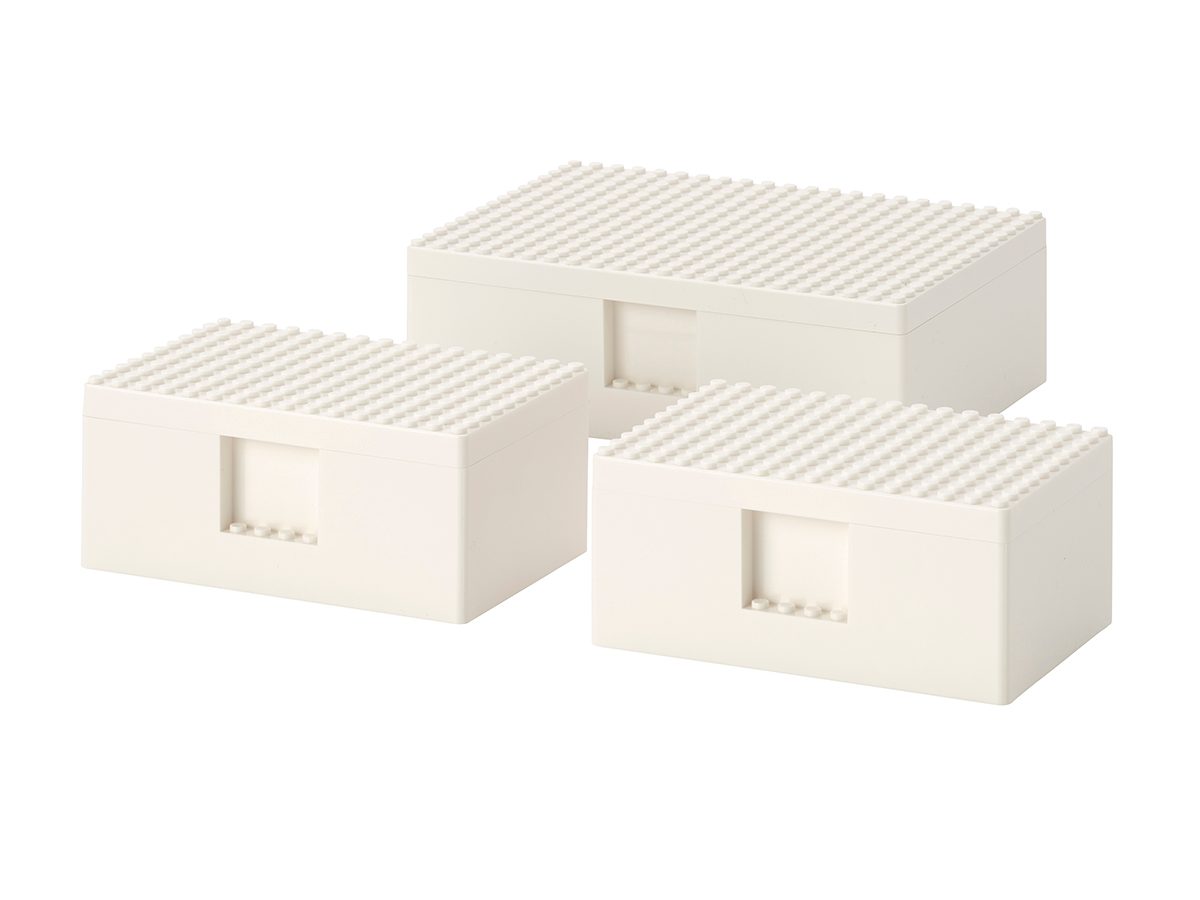
Will the collection make it more likely that kids will keep their LEGO construction sites tidy? It’s possible, says Rasmus Buch Løgstrup, designer at the LEGO Group, but that’s not necessarily his biggest concern. “When it is time for play, it should be okay to make a mess. Kids don’t see it as mess, they see a creative environment. But it is also a human need to organize.”

Unlike some LEGO building sets that come with step-by-step instructions to create a predetermined structure, the assorted bricks in Bygglek are designed with free-form play in mind. “The box itself can be a house, a swimming pool, a sports arena,” explains Løgstrup. “There is no right or wrong.”
Next, check find out five things you won’t see at IKEA Canada anymore.
Ever take a big bite of a refreshing salad—only to feel grit between your teeth? Yuck. If not rinsed properly, salad greens can carry a lot of dirt, sand and other contaminants that you do not want to eat. Read on to find out how to wash salad greens the right way. (Spoiler: If you’re rinsing them under the faucet, you’re doing it wrong.)
When to Wash Salad Greens
You can wash your greens as soon as you get home from the store; or wait to wash them until you’re prepping for a meal. There’s no wrong answer, so ultimately it comes down to personal preference. If you like to throw together quick salads for lunch, you might want to have your lettuce washed, shredded and ready to grab from the fridge. (Learn how long your fresh produce will last with this handy storage guide.)
Do I Have to Wash Pre-Washed Lettuce?
The quick answer is: yes, you probably should wash pre-washed lettuce. No matter what the bag claims, pre-washed lettuce might not be as clean as you think. The Food and Drug Administration (FDA) encourages lettuce be washed with a bleach solution to kill harmful bacteria. The problem is, sometimes traces of bleach are left on the lettuce—and no one wants a bleach salad. (No one wants digestive issues either—this is what can happen if you don’t wash your produce.)
Furthermore, studies have found that the bleach solution isn’t always effective; meaning contaminates can still make their way to your kitchen even after the bleach treatment. So to be absolutely sure your pre-washed lettuce is free of both chemicals and bacteria, it’s best to wash it again.
The Tools You Need
- Salad spinner
- Kitchen towels
- Large bowl
How to Wash Your Lettuce
Step 1: Fill your sink
Fill your sink (or a large clean bowl) with cold water. If you use your sink, be sure to wash it thoroughly beforehand.
Step 2: Dunk the greens
Separate the greens and dunk them in the cold water. Swirl and agitate the water with the greens inside, so that the water gets into all the little nooks and crevices of the leaves.
Step 3: Let them soak
Leave the greens floating in the water for at least 10 minutes or so. As they soak, dirt and sand will fall to the bottom of the sink or bowl.
Step 4: Dry the greens
Lift the greens out and give them a gentle shake to remove any excess water. Then, place your greens in a salad spinner (don’t overload it) and spin to dry.
If you don’t have a salad spinner, try this hack: Wrap the wet greens in a couple of clean kitchen towels, then place the whole bundle in a plastic grocery bag. Tie the bag, and while holding the handles tightly, spin the bag around vigorously using arm circles. The motion will make the water slide off the leaves and soak into the towels. You’ll be a human salad spinner! (Discover these 40 kitchen hacks you’ll wish you knew sooner.)
What Lasts Longer, Shredded Lettuce or Whole Heads?
Your shredded lettuce can last up to a week when properly stored, but whole heads last one to three weeks in the refrigerator. You should only wash and prep as much lettuce as you plan to use.
Next, learn the answer to this age-old question—do you need to wash avocados?
Before the COVID-19 pandemic, going on a cruise to a new destination was a popular way for people to travel to new countries while being mindful of their travel budget. However, have you ever wondered what happens to cruise ships after they’re no longer in use? While things are uncertain right now, here’s what travel could look like after coronavirus.
Where do old cruise ships go?
Like every other work of machinery in the world, cruise ships can’t run forever. Typically, a cruise ship is built to run about 30 years. When a cruise ship is no longer running smoothly or it’s time for it to retire, there are a few different factors that determine its fate. Two prime considerations include the state of the ship, along with how many potential buyers are interested in snapping it up. “In some cases, retired ships could have a second life and be sold to other companies,” Colleen McDaniel, editor-in-chief of Cruise Critic, tells Reader’s Digest. “In other cases, they’re sold for scrap—meaning the ship will dock at a shipyard and the most valuable parts will be sold piece-by-piece, and the rest of the ship stripped.”
While cruise ships can be sold to other cruise lines and repurposed that way, given the current climate with the pandemic, ships may skip that route and go straight to the scrapyard. “Currently, as cruise lines are retiring select ships, we’re seeing a mix of both—some ships have been transferred to different cruise lines, others are headed to shipyards to be sold as scrap,” says McDaniel. Find out some of the ways cruises could change after coronavirus.
How is an old cruise ship taken apart?
Like retired airplanes, cruise ships have their own final resting place. “The term ‘cruise ship graveyard’ is usually meant to describe those final destinations for ships that have been scrapped,” McDaniel says.
You might be surprised to know that the largest scrap yard for ships in the world located in Alang, India, recycles around 50 percent of decommissioned cruise ships. Cruise ships either use their own power to reach Alang, or they’re towed, which is a bit more difficult. Then there is a process in order to tear cruise ships down.
“If the ship is no longer profitable or has mechanical or other systemic issues, then it will be sold for demolition. In recent years, the most popular place for old cruise ships to get demolished has been Alang, in India, where there is a ten-mile stretch of beach with a 25-foot tidal variance,” says Peter Knego, a cruise journalist and historian. “Ships are beached there at high tide, then when the tide recedes, workers head out, remove all salvageable fittings and begin cutting the ship down. As the ship gets cut away, it is gradually winched ashore until it finally disappears.”
Cruise ships as tourist attractions
Another option is to use retired cruise ships as popular tourist attractions. While we may never know the mysteries of the Titanic, one of the most famous cruise liners of all time, we can get an inside look at other ships like the Queen Mary. With tours and attractions and various dining options available, you’re able to learn more about Queen Mary’s history and learn fun facts, like how the building of this ship was a technological achievement.
What will happen to cruise ships due to the pandemic?
The pandemic has upended many aspects of everyday life. The coronavirus is costing the world a lot of money, and there have been dire consequences for the travel industry. This includes cruise ships. “The pandemic has sped up the process of cruise ship disposal since cruise lines cannot afford to keep vast fleets in warm layup (with full crews to make sure all systems are in working order, the ship is clean, safe, etc.) or even cold layup,” says Knego.
Sadly, many cruise ships have had their lives cut short due to the pandemic. “The eighteen ships that the Carnival Corporation (parent company of Carnival Cruises with multiple cruise lines) and three that Royal Caribbean have thus far disposed of were still viable and popular ships until the pandemic struck,” explains Knego. “For the most part, they could have all been kept in service for several more years but without the demand and with the overhead being so high, they had no choice and had to begin paring down their fleets. If the pandemic continues for much longer, what we have seen thus far is only the beginning of a much larger purge.”
Next, take a peek inside the world’s biggest cruise ship.
What is there to say about Princess Diana’s wardrobe that hasn’t been said already? Her style was so down-to-earth, unique and elegant that future royals like Kate Middleton and Meghan Markle have worn many outfits that instantly evoked looks Diana wore. (Take a closer look at Kate Middlton’s transformation since becoming a royal.)
But there was one significant thing the princess didn’t wear that helped cement her image as an approachable, caring member of the royal family. You may have noticed that Queen Elizabeth wears gloves all the time. Indeed, the very idea of a queen or a princess probably conjures up the image of a woman doing a dainty “royal wave” with gloved hands. And yet the People’s Princess herself chose not to wear gloves at social engagements. (Here are the 13 times Princess Diana’s body language told the real story.)
Why didn’t Diana wear gloves?
According to the 2017 exhibition “Diana: Her Fashion Story” that was shown at Kensington Palace, Diana forwent gloves pretty much from the get-go of her royal career. The reason she didn’t wear them was simple: She preferred actually making physical contact with people she met. She thought a handshake or comforting clasp lost meaning when her hands were covered with gloves, and she wanted to connect with people as directly as possible.
And her choices made an impact! One iconic photo in 1991 showed her shaking the hand of an AIDS patient. It made front-page news and helped chip away at some of the stigma surrounding HIV/AIDS. Groundbreaking gestures like this are part of why we’re still so fascinated with Princess Diana.
Are gloves part of royal protocol?
Were Diana’s gloveless hands an outright breach of royal protocol? Sort of, but it wasn’t very strict. Historically, royal women had indeed worn gloves, as a status symbol and a representation of purity. But that tradition was waning anyway come the 1990s. In fact, Diana’s fashion choice helped change the protocol, allowing gloves—or no gloves—to be more of a personal choice.
Today, the reason Queen Elizabeth wears gloves actually has more to do with health and cleanliness. They keep her protected from germs while she’s shaking hands with statespeople and admirers, and she even keeps a couple of spare pairs with her.
Next, take a look at these 20 rarely seen photos of Princess Diana.
Sources:
- Express: “Princess Diana never did this one thing during royal tours – for a heartwarming reason”
- Grazia: “The Reason Why Princess Diana Stopped Wearing Gloves Will Make You Smile”
- Marie Claire: “This is why Princess Diana never wore gloves”
Colourful leaves, cozy sweaters, a return to cooler weather, pumpkin spice everything: It’s no surprise that fall is a favourite season for many. Not everyone feels this way, however, and a significant amount of people actually do experience autumn anxiety, says Carrie Landin, a psychologist with UCHealth Integrative Medicine Center and a clinical instructor at the University of Colorado, department of psychiatry residency program.
What is autumn anxiety?
Autumn anxiety is an increase in worry, fear, and other negative emotions related to the changing of the seasons. Just like there are many wonderful things to appreciate about the fall, there are also a lot of events that typically happen from September through December that can spur worry, particularly in people already prone to anxiety, Landin says.
The two sources of autumn anxiety
This phenomenon is the result of physical changes that affect brain chemicals and environmental changes that affect daily life, says Kimberly Asner-Self, a licensed professional counsellor, program director and associate professor in clinical mental health counselling at Touro College’s School of Health Sciences in New York.
Physical changes
As the earth transitions from summer to fall, daylight decreases, triggering chemical changes in the brain in some people, Asner-Self says. “There is some evidence that in the Northern hemisphere during fall, as the Earth tilts away from the sun, our moods are affected. Less daylight leads to lower levels of serotonin, norepinephrine, and dopamine, the neurotransmitters that control our emotions,” she says. “As these neurotransmitters drop, the body responds by increasing levels of cortisol, the ‘stress hormone’ released in situations where we perceive threat. When there is more cortisol released than needed, then we can become anxious.”
These chemical changes lead to physical symptoms, including disturbances in sleeping patterns, symptoms of depression, and increased anxiety, she says.
Together, these chemical changes and physical symptoms are known as seasonal affective disorder (SAD). This term describes the serious decline in mood that can happen in the fall and winter months. Many people recognize SAD as a cause for depression, but they may not realize that it also encompasses anxiety symptoms, Asner-Self says.
Environmental changes
It’s not just the longer hours of darkness. Changes in your social or physical environment brought on by autumn can cause “anticipatory anxiety,” Landin says. “When we know there is the potential for stress ahead, we tend to anticipate the problems, feeling anxious before they even happen, Landin says. “It’s very common for people to feel this during autumn because they are anticipating the variety of stressors that come with colder weather and the end of the calendar year,” she says.
It’s also possible to experience anticipatory anxiety in relation to positive things, like seeing family or upcoming holidays. “Fall is a wonderful time of year with many fun things happening so it can be confusing when we feel excited but also anxious and that confusion can lead to more anxiety,” Landin says.
Taming autumn anxiety
Dealing with autumn anxiety starts by identifying what your personal triggers are and making a plan to manage them before they start to feel overwhelming or out of control, says Mayra Mendez, a licensed psychotherapist, marriage and family therapist, and program coordinator of mental health services at Providence Saint John’s Hospital in Santa Monica, California. To help you figure out what’s causing your anxiety this fall, we asked our experts to share the most common triggers they see and how to manage them.
The beginning of a new school year
A new school year causes a lot of excitement but it also brings a lot of added responsibilities, particularly for parents, Mendez says. This is especially true in the middle of a pandemic. “Students and parents of students now have extra time commitments, expenses and social stresses, all of which can be very anxiety-inducing,” she says.
How to deal: Decide right now what is necessary and what is just nice and then use your limited resources based on those priorities, Mendez says.
Losing the freedom of summer
Between vacations and school breaks, the whole vibe of summer is more relaxed. Leaving that behind to return to a stricter schedule in the fall can cause anxiety, Landin says.
How to deal: Schedule regular breaks and plan future vacations so you have things to look forward to, she says. Even if you’re just daydreaming, refocusing your mind on the positive will help reduce your anxiety.
Cold and flu season and coronavirus
Going into the season of coughs and sniffles is stressful most years but with the COVID-19 pandemic in full force, many people are experiencing an extreme amount of anxiety around getting sick this fall, Mendez says. If that’s you, you’re certainly not alone in your worries.
How to deal: “Self-care is so important, both for your mental health and to boost your immune system,” she says. This includes getting adequate sleep, exercising and eating a healthy diet, but don’t forget to add in some things just for fun, like taking a long bubble bath or getting a fancy latte.
More hours of darkness
There’s nothing you can do about the Earth’s spot in its orbit around the sun but recognizing the lengthening darkness as a source of your increasing anxiety and acknowledging that it has a physiological cause can help you mentally, Asner-Self says.
How to deal: Make it a top priority to get sunlight on your face, first thing in the morning, every morning, she says. Taking a walk outdoors will get you light exposure, fresh air and exercise, but on days when that isn’t an option, sitting for 30 minutes in front of a light box can help. If that isn’t enough, talk to your doctor about medications available for treating SAD. (Learn to spot the signs you’re not getting enough sunlight.)
Bad news
That steady stream of doom-laden headlines on news sites, Facebook and Twitter can be anxiety-provoking. Between the pandemic, politics and natural disasters, there’s plenty happening to give everyone some sleepless nights, Mendez says. Some people, however, experience more than normal worry and find themselves sucked into a vortex of bad news, mistrust and fear.
How to deal: “Turn off the news and social media. Reducing your media consumption can go a long way in reducing your anxiety,” she says. Sure this may mean that you miss some events but your mental health needs to be your first priority, she says. Set a firm limit, like only checking the news once per day, and stick to it. Here are more ways to cope when the world seems like a horrible place.
Upcoming holidays
“Isolation, family problems, work demands, health issues and money problems can all come together to make the holidays a very stressful time of year and yet the message is that we should all be filled with joy,” Landin says. The reality is that they can be both joyful and anxiety-provoking, at the same time.
How to deal: Plan ahead as much as possible by setting a budget and buying gifts early, scheduling holiday events, and setting menus, Mendez says. “After that, the best thing you can do is learn to say no and draw firm boundaries about what you can and cannot do during this season,” she says. Find out more ways to relieve holiday stress.
The year ending
Fall is the season of year-end performance reviews both at work and personally. As you review what you’ve accomplished and what goals you’ve failed to meet, you may experience a lot of anxiety. “A lot of people feel like they’ve failed as the end of the year suddenly feels close and they still have a lot of things undone,” Mendez says.
How to deal: The end of the year is a date on the calendar, nothing more. “There’s nothing that says you can’t keep working on your goals or set new goals at any point,” she says. “Setting an arbitrary deadline is unnecessary and adds stress.” (In the same vein, here are practical tips on how to embrace your next milestone birthday.)
Party season
Fall is the season for office holiday parties, Thanksgiving dinners with extended family, going home for Christmas, Halloween parties, and many other seasonal get-togethers. As the weather gets colder, it’s natural to want to spend more time gathering indoors with loved ones but for introverts or people with social anxiety, this is their worst nightmare, Landin says.
How to deal: “It’s perfectly OK to say no,” Mendez says. “Pick a few gatherings that feel important or fun and then turn down any other invitations.” This is especially true this season as COVID-19 restrictions are still in force in many places, limiting the amount of people who can gather in one place. (Here’s more expert advice on how to overcome social anxiety during the holidays.)
Stop anticipating problems
One of the best things you can do to reduce autumn anxiety is to stop anticipating problems. If you’re worried that the autumn will be awful then you will be looking for bad things. “You can only manage the moment, what’s happening right now, you can’t jump into the future and manage it,” Landin says. “I recommend practicing mindfulness as a way to keep your focus on the present. When you stay present-focused you are moving your attention away from your worries about what ‘could’ happen to what is actually happening right now.”
When anxious thoughts about the future start to creep in, and you start to anticipate bad things happening, bring your awareness to something that anchors you in the moment, like your breath and work to keep your focus there until you feel like it’s easier to let go of the worries, she says.
Next, find out what happens when you start meditating every day.

